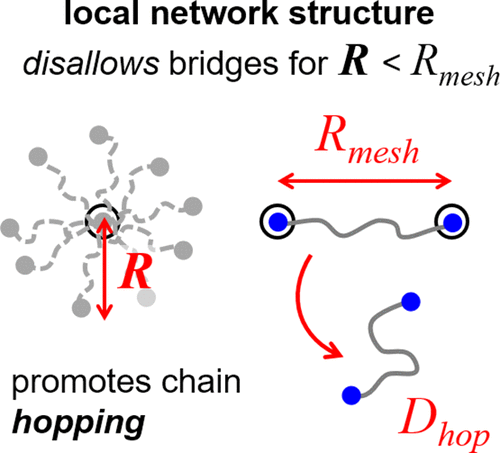当前位置:
X-MOL 学术
›
J. Am. Chem. Soc.
›
论文详情
Our official English website, www.x-mol.net, welcomes your
feedback! (Note: you will need to create a separate account there.)
Mechanisms of diffusion in associative polymer networks: evidence for chain hopping
Journal of the American Chemical Society ( IF 14.4 ) Pub Date : 2018-10-01 , DOI: 10.1021/jacs.8b07908 Peter B Rapp 1 , Ahmad K Omar 1 , Bradley R Silverman 1 , Zhen-Gang Wang 1 , David A Tirrell 1
Journal of the American Chemical Society ( IF 14.4 ) Pub Date : 2018-10-01 , DOI: 10.1021/jacs.8b07908 Peter B Rapp 1 , Ahmad K Omar 1 , Bradley R Silverman 1 , Zhen-Gang Wang 1 , David A Tirrell 1
Affiliation

|
Networks assembled by reversible association of telechelic polymers constitute a common class of soft materials. Various mechanisms of chain migration in associative networks have been proposed; yet there remains little quantitative experimental data to discriminate among them. Proposed mechanisms for chain migration include multichain aggregate diffusion as well as single-chain mechanisms such as "walking" and "hopping", wherein diffusion is achieved by either partial ("walking") or complete ("hopping") disengagement of the associated chain segments. Here, we provide evidence that hopping can dominate the effective diffusion of chains in associative networks due to a strong entropic penalty for bridge formation imposed by local network structure; chains become conformationally restricted upon association with two or more spatially separated binding sites. This restriction decreases the effective binding strength of chains with multiple associative domains, thereby increasing the probability that a chain will hop. For telechelic chains this manifests as binding asymmetry, wherein the first association is effectively stronger than the second. We derive a simple thermodynamic model that predicts the fraction of chains that are free to hop as a function of tunable molecular and network properties. A large set of self-diffusivity measurements on a series of model associative polymers finds good agreement with this model.
中文翻译:

缔合聚合物网络中的扩散机制:链跳的证据
由遥爪聚合物可逆缔合组装而成的网络构成了一类常见的软材料。已经提出了关联网络中链式迁移的各种机制;然而,几乎没有定量的实验数据来区分它们。所提出的链迁移机制包括多链聚合扩散以及单链机制,例如“行走”和“跳跃”,其中扩散是通过相关链的部分(“行走”)或完全(“跳跃”)脱离来实现的段。在这里,我们提供的证据表明,由于局部网络结构对桥形成施加了强烈的熵惩罚,跳跃可以主导关联网络中链的有效扩散;链在与两个或多个空间上分离的结合位点结合时变得构象受限。这种限制降低了具有多个关联域的链的有效结合强度,从而增加了链跳跃的可能性。对于遥爪链,这表现为结合不对称性,其中第一个缔合实际上比第二个缔合更强。我们推导出一个简单的热力学模型,该模型预测自由跳跃的链的分数作为可调分子和网络属性的函数。对一系列缔合聚合物模型进行的大量自扩散率测量发现与该模型非常吻合。
更新日期:2018-10-01
中文翻译:

缔合聚合物网络中的扩散机制:链跳的证据
由遥爪聚合物可逆缔合组装而成的网络构成了一类常见的软材料。已经提出了关联网络中链式迁移的各种机制;然而,几乎没有定量的实验数据来区分它们。所提出的链迁移机制包括多链聚合扩散以及单链机制,例如“行走”和“跳跃”,其中扩散是通过相关链的部分(“行走”)或完全(“跳跃”)脱离来实现的段。在这里,我们提供的证据表明,由于局部网络结构对桥形成施加了强烈的熵惩罚,跳跃可以主导关联网络中链的有效扩散;链在与两个或多个空间上分离的结合位点结合时变得构象受限。这种限制降低了具有多个关联域的链的有效结合强度,从而增加了链跳跃的可能性。对于遥爪链,这表现为结合不对称性,其中第一个缔合实际上比第二个缔合更强。我们推导出一个简单的热力学模型,该模型预测自由跳跃的链的分数作为可调分子和网络属性的函数。对一系列缔合聚合物模型进行的大量自扩散率测量发现与该模型非常吻合。











































 京公网安备 11010802027423号
京公网安备 11010802027423号